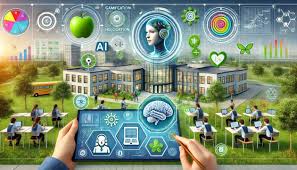The education sector is evolving at a rapid pace, driven by technological advancements, innovative teaching methods, and a growing focus on inclusivity and personalized learning. Trends in Education Staying ahead of these trends is crucial for educators, students, and policymakers. In this article, we explore the key trends shaping the future of education.
1. Artificial Intelligence in Education
AI is revolutionizing education by offering personalized learning experiences. Adaptive learning platforms analyze student performance to tailor lessons to individual needs. Tools like AI-powered chatbots assist with queries, while grading automation saves teachers significant time. AI’s potential to identify learning gaps and recommend targeted solutions is transforming how students learn.
2. Hybrid and Blended Learning
The pandemic accelerated the adoption of hybrid learning models, which combine online and in-person instruction. This approach offers flexibility, allowing students to learn at their own pace while benefiting from face-to-face interactions. Schools and universities are increasingly investing in digital infrastructure to support this trend.
3. Gamification in Education
Gamification integrates game elements into learning environments, making education more engaging and interactive. By incorporating rewards, leaderboards, and challenges, educators can motivate students and enhance retention. This trend is particularly effective in STEM subjects and language learning.
4. Focus on Social and Emotional Learning (SEL)
There is a growing recognition of the importance of SEL in fostering well-rounded development. Schools are integrating SEL programs to teach skills such as empathy, emotional regulation, and teamwork. These programs prepare students for both academic and personal success.
5. Virtual and Augmented Reality
VR and AR technologies are creating immersive learning experiences. Students can explore historical sites, conduct virtual science experiments, or practice surgical techniques in a risk-free environment. These tools enhance understanding and make learning more memorable.
6. The Rise of Microlearning
Microlearning breaks down complex topics into bite-sized modules, making it easier for learners to grasp and retain information. This trend is especially popular in professional development and online courses, where learners prefer short, focused lessons.
7. Increased Focus on Inclusivity
Education systems are emphasizing inclusivity by addressing the needs of diverse learners. Tools such as screen readers, captioning software, and multilingual resources ensure equitable access to education. Additionally, culturally responsive teaching practices promote inclusivity in classrooms.
8. Data-Driven Decision Making
Analytics are playing a pivotal role in education. Schools and universities use data to track student performance, optimize curricula, and improve resource allocation. Predictive analytics help identify at-risk students and provide timely interventions.
9. Sustainability in Education
Sustainability is becoming a core focus in education, with institutions adopting eco-friendly practices and incorporating environmental education into curricula. This trend prepares students to address global challenges such as climate change and resource management.
10. Globalization of Education
The digital age has made education more accessible globally. Online platforms connect learners with courses and instructors worldwide. This globalization fosters cross-cultural understanding and creates opportunities for collaborative learning.
Conclusion
The trends in education reflect a dynamic landscape that prioritizes technology, inclusivity, and adaptability. As these trends continue to shape the future, they promise to make education more effective, engaging, and accessible for all. Embracing these changes will ensure that learners are equipped with the skills needed to thrive in a rapidly evolving world.
